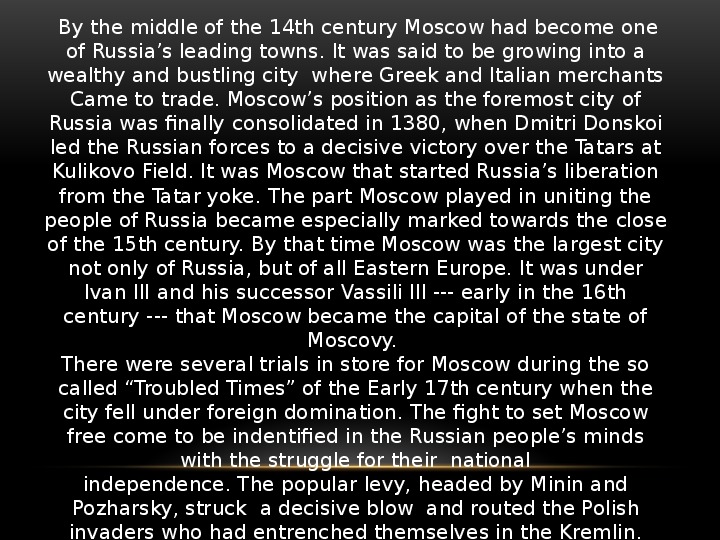Данная презентация предназначена для изучения разговорного английского языка для студентов. Закрепление лексических навыков. Активизация знаний. Контроль орфографических и лексико-грамматических навыков по английскому языку студентов.
Краткое содержание:
В 1154 году на месте слияния рек Москвы и Неглинной был построен первый небольшой укрепленный город. В те времена Москва была лишь небольшим пограничным постом Ростовского и Суздальского княжеств. В 1237 году она попала под ярмо татар и долгое время после этого не упоминалась в летописях. Он появляется только к концу 13-го века (это время прочно утвердилась в качестве главных российских городов ) в 13-м веке город был разрушен во время нашествия и на протяжении многих лет он платил дань татарским Ханам, но к концу 14-го века он вырос против этих правил, иногда дерутся, иногда платить выкуп. В XIV и XV веках Россия стала национальным государством, а Москва приобрела все возрастающее стратегическое и экономическое значение. Поскольку Москва была военным, а также административным и экономическим центром, ее правители продолжали возводить крепостные стены и укрепления.
«Moscow:
Its Past and
Present»
From the ancient History of
Moscow
The first mention of Moscow to be
fond in the historical records dates
back to the year 1147. In that year
it was founded by Yuri Dolgorukiy in
April 1147.
In 1154 the first small fortified town was known to have
been built at the confluence of the Moscow and
continued to erect ramparts and fortifications.
Neglinnaya rivers. In those days Moscow was merely a
small frontier post of the Rostov and Suzdal principality.
In 1237 it fell under the yoke of the Tatars and for a
long time after there is no reference to it in the records.
It reappears only towards the close of the 13-th century
(this time to become firmly established as the foremost
of Russian towns ) In the 13-th century the city was
razed during the invasion and for many years it paid
tribute to the Tatar Khans, but towards the end of the
14-th century it rose against those rules, sometimes
fighting, sometimes paying ransom. The 14th and the
15th centuries saw the rise of Russia as a national state
with Moscow, assuming ever-growing strategic and
economic importance. As Moscow was a military as well
as an administrative and economic centre, its Rulers

By the middle of the 14th century Moscow had become one
of Russia’s leading towns. It was said to be growing into a
wealthy and bustling city where Greek and Italian merchants
Came to trade. Moscow’s position as the foremost city of
Russia was finally consolidated in 1380, when Dmitri Donskoi
led the Russian forces to a decisive victory over the Tatars at
Kulikovo Field. It was Moscow that started Russia’s liberation
from the Tatar yoke. The part Moscow played in uniting the
people of Russia became especially marked towards the close
of the 15th century. By that time Moscow was the largest city
not only of Russia, but of all Eastern Europe. It was under
Ivan III and his successor Vassili III --- early in the 16th
century --- that Moscow became the capital of the state of
Moscovy.
There were several trials in store for Moscow during the so
called “Troubled Times” of the Early 17th century when the
city fell under foreign domination. The fight to set Moscow
free come to be indentified in the Russian people’s minds
with the struggle for their national
independence. The popular levy, headed by Minin and
Pozharsky, struck a decisive blow and routed the Polish
invaders who had entrenched themselves in the Kremlin.
The Burning of Moscow,
A.D. 1812
Bitter tribulation came to
Moscow with the war of
1812. With the French
emperor Who expected
the Russian troops to
engage his army first came
within sight of Moscow, he
gazed long time and
thoughtfully on that goal of
his wishes. Mural was the
first to enter the gates with
his splendid cavalry; but as
he passed along the
streets he was struck by
complete solitude that
surrounded him: a
deserted and abandoned
city was the prize for which
such unparalleled efforts
As night drew, Napoleon entered the
city and on appointing Mortier
Governor commanded him to abstain
from all pillage. For this said he, “you
shell be answerable with your life.
Defend Moscow against all, whether
friend or foe.” Mortier obeyed but felt
that some calamity was hanging over
the silent capital. The feeling did not
deceive him at midnight when the cry
of “Fire” reached his ear, he realized
that it was the burning of Moscow, but
he too tired to take action.
Soon the city presented a
spectacle the like of which
had never been before and
which baffles all description.
Flames burst on every side
and were raging through the
whole city until the latter
became one gigantic flame
waving to and fro, one
boundless sea of fire.
Russian patriots decided to
set Moscow ablaze rather
then surrender their beloved
city to Napoleon: it was at
the approaches of Moscow
that the Russian people
usually inflicted serious
defeat on the foreign
invaders who always
Moscow. The Grate
Patriotic War.
During World War II, Moscow was the goal of the
German offensive, Although the Germans Columns
were stopped only about 40 km from the city’s
center, Moscow suffered virtually no war damage.
